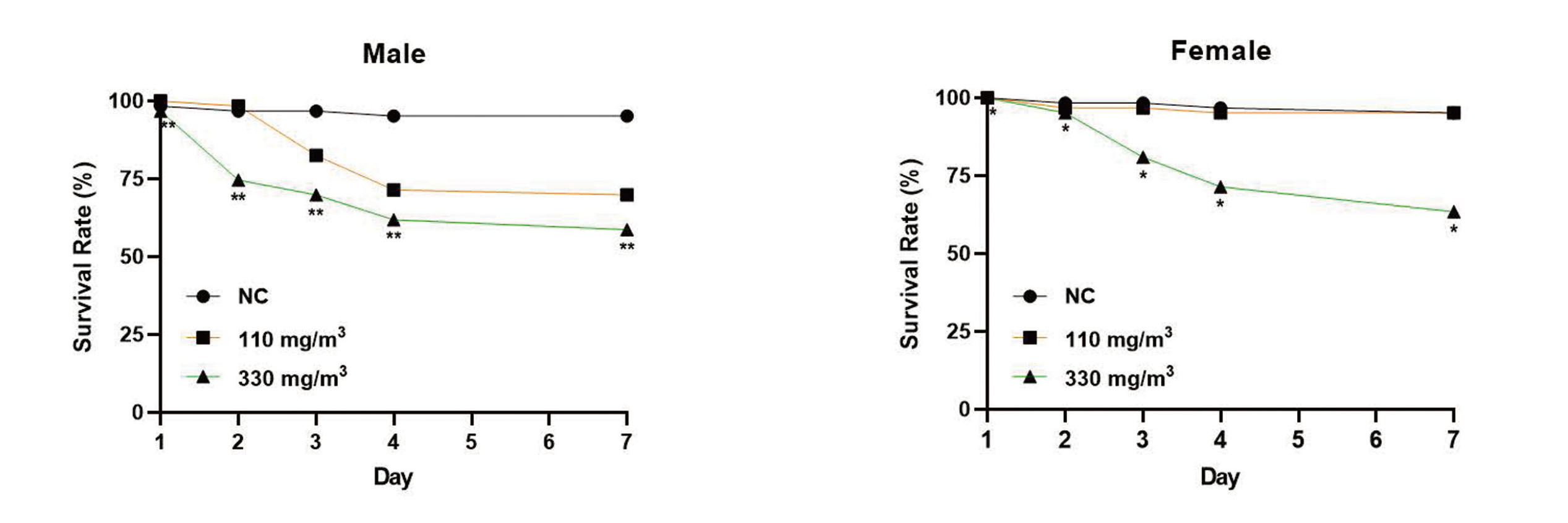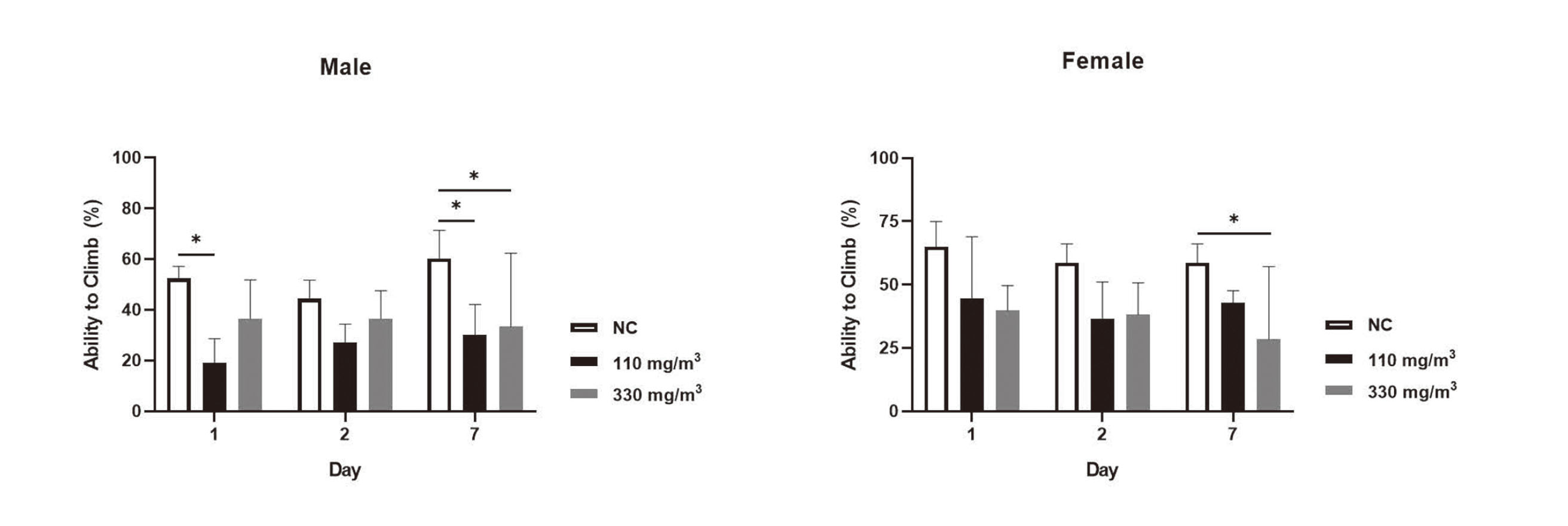2024 年 49 巻 2 号 p. 49-53
2024 年 49 巻 2 号 p. 49-53
Drosophila melanogaster (D. melanogaster) is a promising model biological system. It has a short life cycle and can provide a substantial number of specimens suitable for comprehensive genetic and molecular analyses in a short time. In this study, we investigated the acute inhalation toxicity of methylisothiazolinone (MIT) and chloromethylisothiazolinone (CMIT) in a D. melanogaster model. During exposure, environmental conditions, mass median aerodynamic and geometric standard diameters were measured. After inhalation exposure, the survival rate, climbing ability, and bang sensitivity were measured on days 1, 2, and 7. Notably, the survival rate of flies decreased in an exposure concentration-dependent manner. Climbing ability and bang sensitivity were also altered in the MIT/CMIT group, compared with the negative control group. Overall, these results provide a reliable D. melanogaster model system for inhalation toxicity study.
D. melanogaster, commonly known as the fruit fly, has distinct advantages as a model biological system. These include ease of use, cost and time efficiency, rapid genetic manipulation, a fully sequenced genome, and an understanding of the toxins associated with human diseases (Brischigliaro et al., 2023). In this study, we performed inhalation toxicity assessments using D. melanogaster as an alternative animal model. This model, with its intricate respiratory system that includes tracheal structures (Hayashi and Kondo, 2018), is well suited for inhalation toxicology research.
Assessing acute inhalation toxicity has important implications for understanding chemical exposure in the environment. Moreover, a comprehensive understanding of the risks of acute inhalation toxicity is crucial to ensure the safety of chemicals, enhance public health, and provide guidelines for the management of chemically based products (Jackson et al., 2018). Chloromethylisothiazolinone (CMIT) and methylisothiazolinone (MIT) are widely used in industrial and household products (Kim et al., 2022). However, the use of CMIT/MIT has raised concerns about safety, particularly when administered via inhalation. Here, we conducted acute inhalation toxicity testing of CMIT/MIT using a D. melanogaster model to assess its potential application for inhalation toxicity studies.
Drosophila melanogaster (D.melanogaster) used in the experiment was provided by the Korea Drosophila Resource Center (KDRC). D. melanogaster was cultured under a 12 hr/12 hr light/dark cycle in a dedicated culture chamber maintained at 25°C and 60% humidity. The fresh food vial (Hansol Tech, Republic of Korea) was replaced with a new one every 2 to 3 days to provide optimal environmental conditions for the fruit flies to survive. D. melanogaster were mated with males and females in a 1:2 ratio and the larvae produced were reared. The population was controlled according to the purpose of the experiment.
Chemicals and acute inhalation exposureIn this study, an acute inhalation exposure was conducted using flies cultured for 5 to 7 days. A rack was set up in the exposure chamber, and tubes containing 7 flies per vial were placed in the appropriate positions for each of the female and male flies. To verify the exposure concentration levels, a port vial for concentration sampling was also placed. After acclimation for 20 min in a small whole-body exposure chamber, they were exposed to CMIT/MIT concentrations of 110 and 330 mg/m3 for 1 hr. During the exposure, changes in pressure, O2, CO2, and concentration of CMIT/MIT were monitored. CMIT/MIT (CAS number: 26172-55-4, Sigma-Aldrich, USA) were diluted with distilled water for exposure.
Environmental monitoring and survival rateOxygen and carbon dioxide concentration were measured at each 25, 36, and 50 min after initiating exposure, using a portable combined MultiRAE Lite PGM-6208-CO2 monitor (RAE Systems, Sunnyvale, CA, USA), respectively. For each exposure group, aerosol particle size was measured using a cascade impactor (Mini MOUDI 135-6S, MSP Corporation, Shoreview, MN, USA), and mass median aerodynamic diameter (MMAD) and geometric standard deviation (GSD) values were calculated. After exposure, flies were transferred to culture vials and monitored for symptoms and survival rates at 1, 2, 3, 4, and 7 days.
Climbing and vortex assayAfter the inhalation exposure, flies were placed in vials containing medium at room temperature for 1 hr to recover stress induced by exposure. Following this recovery period, the flies (n=21) were divided into three separate measuring cylinders for each exposure group and prepared for climbing and vortex analysis. The flies that were exposed to CMIT/MIT were given approximately 10 min to acclimate to their environment. To perform the climbing assay, the measuring cylinder was gently tapped on a sponge-covered floor. Subsequently, the number of objects passing through the marked area in the center of the measuring cylinder for about 30 sec was checked for each group. And, in vortex assay, following acclimate time for 10 min., a measuring cylinder was then placed in a vortexer and rotated at speed 6. Then, the number of flies passing a randomly marked area in the center of the cylinder was counted for each group at for about 30-sec intervals.
Statistical analysisAll results are expressed as mean ± standard deviation. Data were tested for equal variances using Bartlett's test and further with two-way analysis of variance (ANOVA) and post hoc Dunnett's test. All statistical analyses were performed using GraphPad Prism v8.0.2 (GraphPad Software, Inc., San Diego, CA, USA), and differences with P-values < 0.05 were considered statistically significant.
In this study, we sought to investigate whether the D. melanogaster model could be an alternative to inhalation toxicity tests using rodents and to suggest an appropriate inhalation toxicity testing methodology.
During acute inhalation exposure of D. melanogaster to CMIT/MIT, we monitored the changes in pressure and O2 and CO2 levels within the chamber. The values of pressure ranged from 43.8 ± 12.5 Pa, while O2 levels remained constant, between 20.7 and 20.9%. The CO2 levels was maintained at 0 ppm, in line with the parameters outlined in the OECD TG 403. CMIT/MIT concentrations were 113 ± 18.60 and 338.60 ± 35.34, indicating that the exposure was conducted within the expected concentration range without significant deviations (Table 1). These results indicate the stability of the exposure method during acute inhalation toxicity assessments in D. melanogaster.
| Parameter | Group | ||||||||
|---|---|---|---|---|---|---|---|---|---|
| NC | 110 mg/m3 | 330 mg/m3 | |||||||
| Pressure (Pa) | 43.8 | ± | 12.5 | 43.8 | ± | 12.5 | 43.8 | ± | 12.5 |
| Oxygen concentration (O2, %) | 20.9 | ± | 0.00 | 20.8 | ± | 0.01 | 20.8 | ± | 0.01 |
| Carbon dioxide concentration (CO2, ppm) | 0.00 | ± | 0.00 | 0.00 | ± | 0.00 | 0.0 | ± | 0.00 |
| Analytical concentration | a ND | 113.00 | ± | 18.60 | 338.60 | ± | 35.34 | ||
| Mass median aerodynamic diameter (MMAD, μm) | a ND | 0.87 | 1.02 | ||||||
| Geometric standard deviation (GSD) | a ND | 1.89 | 1.77 | ||||||
Values are represented as mean ± standard deviations
a not determined
CMIT/MIT, a component of humidifier disinfectants, is associated with adverse effects on the respiratory system upon inhalation (Kim et al., 2022). Notably, the chemical compounds are commonly used as preservatives and biocides in a variety of industrial products (Kim et al., 2019).
Here, we investigated the survival of D. melanogaster following acute inhalation of CMIT/MIT, and the results revealed distinct sex-based differences. In the 110 mg/m3 exposure group, male flies showed mortality from day three after exposure, in contrast to the control group. Female flies had some mortality, but their overall survival rate was notably higher than that of male flies. In the 330 mg/m3 exposure group, males died faster than those in the 110 mg/m3 exposure group from day two, indicating a difference in survival rate. The number of dead animals increased on day three, with 40% of females dying, compared to the NC group (Fig. 1). This study revealed that the mortality rates were influenced by sex following acute inhalation exposure to CMIT/MIT. These findings are consistent with previous studies that have demonstrated sex-specific responses in parameters of toxicity, such as survival rate, in the D. melanogaster model (El Kholy and Al Naggar, 2023). Moreover, transcriptional alterations and metabolic responses were also shown to be sex-specific impacts on this model (Brown et al., 2021). However, further research is needed to determine whether the sex differences in mortality are due to the properties of the substances or to sex-specific effects.

Changes in the survival rate of Drosophila following exposure to CMIT/MIT. P-values as represented as * < 0.05 and ** < 0.01.
Additionally, we observed behavioral effects, including analysis of climbing ability and vortex sensitivity, as well as morphological alterations in Drosophila exposed to CMIT/MIT. No morphological changes were observed in Drosophila; however, behavioral changes were observed immediately after exposure on day 1. On day 2, a decrease in movement speed and the presence of moribund individuals were observed. The climbing analysis showed that compared to the control group, the number of males that appeared normal decreased in the 110 and 330 mg/m3 exposure groups on day 1, compared to the NC group. The number of normal males in the 110 mg/m3 group gradually recovered during the observation period, while a further decrease was observed in the 330 mg/m3 group. Similar results were observed in the female-exposed groups (Fig. 2). The results of the vortex analysis were similar to those of the climbing analysis, with significant changes observed in population death between treatment conditions (Fig. 3).

Alterations in Drosophila climbing ability acute exposure to CMIT/MIT by inhalation. The data are presented with the mean ± standard deviation (SD), with * P < 0.05.

Comparative analysis of bang sensitivity in CMIT/MIT-exposed Drosophila. Data are shown as mean ± standard deviation (SD), * indicates P < 0.05 and ** P < 0.01.
In conclusion, our study provides valuable insights into the potential use of D. melanogaster as an alternative animal model for inhalation toxicity testing. We observed distinct behavioral and mortality changes after acute inhalation exposure to CMIT/MIT, highlighting the sensitivity of this model for identifying adverse effects. Our results were similar to those of animal models, such as rats and mice. These results also suggest that the D. melanogaster model can be used to assess both acute inhalation toxicity and sex-specific toxic effects. Further studies are essential to validate and expand upon these findings in the D. melanogaster model.
This work was supported by the Korea Environment Industry & Technology Institute (KEITI) through the Technology Development Project for Safety Management of Household Chemical Products Program, funded by the Korea Ministry of Environment (MOE) (project number: 202300230430). The fly stock was obtained from the Korea Drosophila Resource Center (KDRC).
Conflict of interestThe authors declare that there is no conflict of interest.